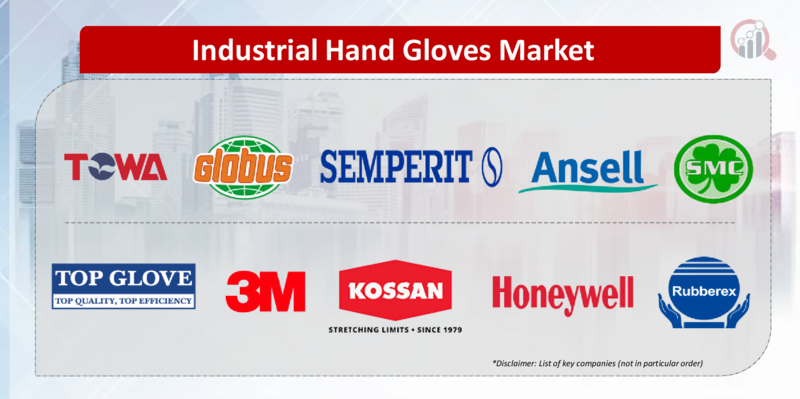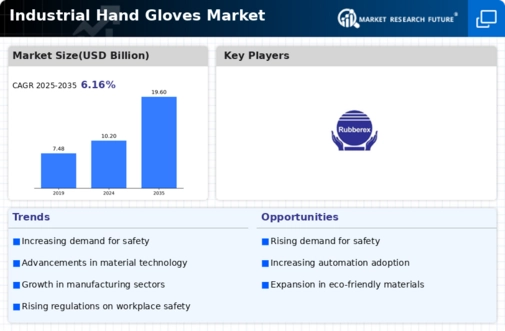Top Industry Leaders in the Industrial hand gloves market

*Disclaimer: List of key companies in no particular order
Top listed global companies in the industry are:
- Towa Corporation
- Top Glove Corporation Bhd
- Shamrock Manufacturing Company, Inc.
- Globus (Shetland) Ltd
- Rubberex
- Semperit AG Holding
- Ansell Ltd
- Honeywell International Inc.
- 3M
- Kossan Rubber Industries Bhd, and others.
Grasping the Market: Navigating the Landscape of Industrial Hand Gloves
The global industrial hand gloves market is a bustling arena where established players compete fiercely for dominance. Understanding the strategies employed by key players, the factors influencing market share, and emerging trends is crucial for navigating this diverse segment.
Key Players and their Strategies:
- Global Goliaths: Titans like Ansell and Honeywell Safety Products leverage their extensive product portfolios, global reach, and brand recognition to maintain a significant market share. Ansell offers diverse materials and coatings for varied applications, while Honeywell focuses on high-performance gloves for demanding tasks.
- Regional Champions: Companies like MCR Safety and Supermax Corporation dominate specific geographies by tailoring solutions to regional regulations and cost dynamics. MCR Safety caters to North America's safety standards with its affordable nitrile gloves, while Supermax excels in cost-effective latex gloves for Southeast Asia.
- Niche Innovators: Companies like Showa and Hartalega Holdings Berhad disrupt the market with unique approaches. Showa focuses on specialty gloves for chemical resistance and dexterity, while Hartalega pushes the boundaries of sustainable production with its natural rubber gloves.
Factors for Market Share Analysis:
- Product Breadth and Depth: Offering a wide range of gloves for diverse materials, hazards, and industries (construction, chemical, healthcare) caters to varied customer needs and expands market reach.
- Material Expertise: Deep understanding of different materials (latex, nitrile, cut-resistant fibers) and their performance characteristics allows for developing gloves with optimized protection and comfort. Ansell's expertise in various materials exemplifies this.
- Cost-Effectiveness and ROI: Balancing advanced features with affordability is crucial, especially in price-sensitive segments. MCR Safety's cost-effective gloves have secured a strong foothold in emerging markets.
- Sustainability Focus: Reducing environmental impact through recyclable materials, energy-efficient production, and responsible sourcing resonates with sustainability-conscious buyers. Hartalega's natural rubber gloves exemplify this trend.
Emerging Trends and Company Strategies:
- Smart Glove Integration: Integrating sensors and communication modules into gloves enables real-time monitoring of hand temperature, pressure, and dexterity, enhancing safety and worker well-being. Showa's smart gloves with haptic feedback exemplify this trend.
- Digitalization and Data-Driven Insights: Connecting gloves to data platforms allows for usage analysis, predictive maintenance, and optimizing glove selection for specific tasks. Honeywell's digital safety platform with glove data integration exemplifies this trend.
- Focus on Specific Industries: Targeting high-growth segments like food processing, electronics, and automotive with specialized gloves and expertise is gaining traction. Supermax Corporation's food-grade gloves illustrate this approach.
- Antimicrobial and Cut-Resistant Innovations: Developing gloves with advanced coatings and fibers to combat microbes and enhance cut resistance caters to growing hygiene and safety concerns. Ansell's antimicrobial coatings and Showa's cut-resistant fibers exemplify these innovations.
Overall Competitive Scenario:
The industrial hand gloves market presents a dynamic landscape where global giants face challenges from regional players and niche innovators. Success hinges on offering diverse product portfolios, embracing material expertise, prioritizing cost-effectiveness and sustainability, and adapting to emerging trends like smart gloves, digitalization, and sector-specific solutions. Companies demonstrating agility, innovation, and a commitment to worker safety and well-being hold a strong hand in this ever-evolving market.
Latest Company Updates:
June 2023:
The third quarter of Top Glove Corp. Bhd's fiscal 2023 loss was lessened, mostly because of higher average selling prices (ASPs) and continued quality and optimization initiatives. According to Top Glove, the group's revenue for the quarter ended May 31 was RM531 million, which was 64% less than the previous year's period. However, the amount was far less than the RM29 million profit declared in the third quarter of 2022. Despite a difficult business environment, the group claimed to have improved its "overall operating performance," partly because of a 6% increase in ASPs. The glove manufacturer said that the group's manufacturing capacity was reduced by 5 billion pieces due to decommissioning, resulting in a total production capacity of 95 billion gloves. In addition, the group said it implemented a "manpower restructuring exercise" but did not elaborate further.









